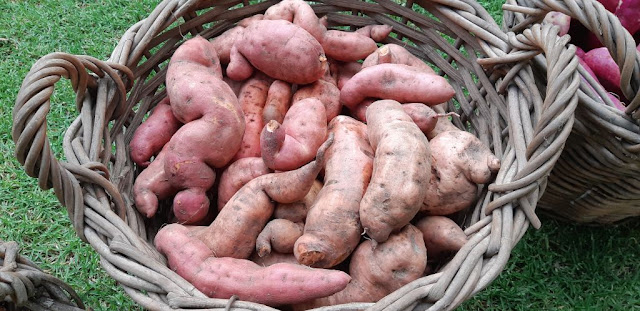More than a year ago, I bought some orange coloured
sweet potatoes from a local supermarket. Although we had a stock of homegrown
sweet potatoes, the unusual colour of those in the supermarket appealed to me.
The colours of the different varieties of vegetables always appeals to me. They
evoke a desire within to plant and eat them.
I decided to keep four for planting when
they ran out. Our homegrown sweet potatoes always run out spectacularly.
Neglected, they can turn the cellar into a scene out of the movie “The Little
Shop of Horrors”. Particularly as the tubers make long ghostly runners in the
dark cellar. There is no mistaking a sweet potato that wants to go back
underground.
With this experience of sweet potato tubers,
I decided to simply let the four orange tubers lie in a protected spot in the
garden office, to encourage the inevitable. After months of waiting and with nothing
happening to them, I had to accept that whatever is sprayed on supermarket
vegetables to make them last longer on the shelf, is obviously inhibiting the
natural development of runners in the tubers.
I did not know what to do. I could not plant them without any sign that
they want to go back to their roots and by now they were no longer fresh enough
to eat. Although they looked as good as the day, I bought them. The chemicals
sprayed on the food we buy at supermarkets, must contain remarkable
preservatives. The thought alone of what the tubers were treated with, dampened
my appetite for them.
I re-discovered that one can encourage root
formation in sweet potatoes by cutting them in half and suspending them in a
jar of water with the cut part barely submerged. Much as one does with an
avocado pip when wanting to encourage it to sprout. I decided to cut the four
tubers in half and with the support of toothpicks, I suspended them in eight
glass jars on a sunny windowsill. I topped up the water as it evaporated.
After two weeks, I noticed spindly white
roots dangling in the water of some of the jars. I was so excited. Soon they
all had roots and leaves. When the leaves were big and strong enough, we
planted them in one half of a vegetable bed.
They took longer than usual to make proper
tubers and in the first week of March, we decided they were ready to be
harvested. Fungai started harvesting and exclaimed in surprise that the plants
were bearing orange and purple sweet potatoes. I could not believe my eyes when
I saw the clumps of intertwined orange and purple sweet potatoes on the same
plants.
The question for me is, did the plant go
back to the original purple tubers in some instances or did the treatment they
received in the supermarket upset their DNA. I decided to see if the orange
tubers that were homegrown, would make runners when they needed to be planted.
They were grown organically and hopefully now will behave like normal
vegetables in future.
In the end, the purple and orange harvest was
quite special. I prefer to imagine that the enchantment of the Towerwater
garden had a hand in the mystery.
Sweet Pepper seeds that my cousin gave me,
surprised by making quite healthy plants. Normally, I struggle to grow Sweet
Peppers. I believed it was because the pH of the soil in the vegetable garden was
not acidic enough for them. However, thanks to these seeds, this year I could
proudly harvest black, red, orange and green Sweet Peppers.
Our garden seems to be in a colourful mood,
and I am really enjoying it. I feel like a child with all the surprises in the
garden adding to a very colourful harvest.






Lovely post. Reminds me of a punnet of tomatoes that I bought at a highly respected store which I forgot in the back of my fridge. Rediscovered six months later and they looked as good as the day I bought them. I had to check the sell-by date to confirm that I wasn't mistaken.
ReplyDelete